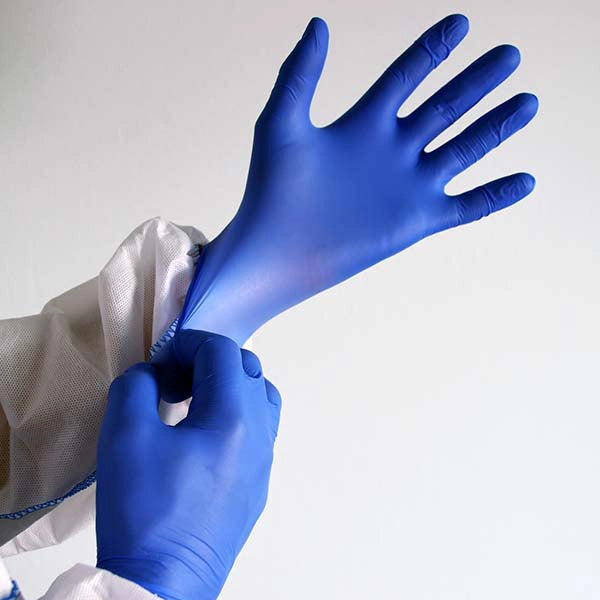To paraphrase The Beatles, All You Need is Glove – the right glove to protect yourself while doing the task at, well, hand. If you’re new to the wide, wide world of disposable gloves, though, making sense of all the different types can be a real Magical Mystery Tour.
We’re here to help cut through it with a look at two of the most popular disposable gloves out there: vinyl and latex gloves.
Latex gloves are a classic option that provide good well-rounded protection in a variety of circumstances.
Vinyl gloves can be an affordable, hypoallergenic choice for light duty work.
Read on to learn more about the pros, cons, and a comparison between vinyl vs. latex gloves.
What Are Vinyl Gloves?
Vinyl gloves are made from PVC (polyvinyl chloride), a petroleum-based film and plasticizer. You’ve probably heard of PVC before in reference to the pipes that run through your bathroom.
Vinyl gloves are made in a similar way to other disposable gloves, though they have some key advantages and disadvantages compared to latex and nitrile gloves.
Advantages of Vinyl Gloves
As the first synthetic rubber gloves on the market, vinyl disposable gloves have been used for decades in non-hazardous medical environments, food service workers and other industries.
The biggest benefit of vinyl gloves is that they’re relatively inexpensive to manufacture, thanks to PVC being one of the most-produced polymers out there. Being cheap to make means they’re relatively cheap to purchase, compared to nitrile or latex gloves.
Another major benefit besides cost to the way vinyl gloves are made is that, since they consist a synthetic material, they’re safe to use for people with latex allergies or sensitive skin.
For low-risk work where a high level of dexterity isn’t required, vinyl disposable gloves can come in handy. They tend to be loose-fitting and comfortable to wear for short periods of time.
Vinyl gloves also have anti-static properties, which makes them helpful for use when working with electronic equipment when even a little static electricity could be problematic. They’re resistant to water, oils, and fats, which is why they’re often used in places like your local deli.
Disadvantages of Vinyl Gloves
While there’s a lot to like about them, vinyl gloves aren’t without their compromises.
While they tend to fit loose, vinyl gloves are more stiff on a molecular level than nitrile and latex gloves. This means they’re less durable and more prone to rips or tears when stretched even a little bit.
That loose fit also makes for poor touch sensitivity, so vinyl gloves aren’t suitable for tasks where a high level of precision is required.
Vinyl gloves can protect the hands in the short term from some chemicals like household cleaners, but they don’t offer much in the way of protection against harsh chemicals. Vinyl gloves also aren’t appropriate for settings where biomedical materials are present.
As a synthetic, non-biodegradable material that also can be easy to rip, vinyl gloves also come with some environmental concerns. That’s true of most disposable gloves, of course, so it’s important to make sure you dispose of your gloves properly when you’ve finished using them.
Uses of Vinyl Gloves
There are several industries and tasks where vinyl gloves are popular:
- Food Preparation and Handling - Since they’re inexpensive and useful for light duty work, vinyl gloves are a natural fit for the restaurant business.
- Cleaning and Sanitation - Vinyl gloves can protect the hands from the lower-risk chemicals used in most basic cleaning tasks.
- Healthcare - Vinyl gloves tend to be used in hospitals for low-risk work like exams, senior care, or janitorial work.
- Painting or Printing - Vinyl gloves can be useful for keeping paint and ink off the hands.
- Cleanrooms and Manufacturing - Vinyl gloves are sometimes used for their anti-static properties.
Of course, this is by no means a comprehensive list: there are a wide variety of tasks where vinyl gloves are an affordable and practical way to protect your hands.
What Are Latex Gloves?
Ever since William Stewart Halsted introduced them in his surgery practice at Johns Hopkins Hospital in the late 1800’s, latex gloves have been ubiquitous throughout the world.
Made from natural rubber, latex gloves are a great choice for a variety of tasks and workplace environments, but they do have a few key drawbacks as well.
Advantages of Latex Gloves
Even if Dr. Halsted was much more limited in his choice of materials for medical gloves 150 years ago than we are today, the staying power of latex gloves is a testament to their utility.
Latex gloves retain the stretchiness of the rubber tree sap they’re made from, which makes them form-fitting and allows for a high degree of dexterity and comfort. The responsiveness of latex gloves also lends them great touch sensitivity, which is crucial for performing delicate tasks safely.
Latex gloves are relatively puncture resistant, and the material holds up better against rips and tears compared to stiffer materials like vinyl.
Beyond just being stretchy, latex gloves provide excellent protection against biohazardous materials like blood or bodily fluids. They can also protect the hands from some dangerous chemicals, though it’s a shorter list than some other types of gloves.
Since they’re made from natural rubber, latex disposable gloves are also biodegradable, which makes them a great choice for people looking to minimize their impact on the environment.
Disadvantages of Latex Gloves
While latex disposable gloves are a popular, versatile choice in a variety of industries, there are some important limitations to consider when choosing between latex vs vinyl gloves.
The biggest issue with latex gloves is, of course, latex allergies. According to the National Institutes of Health, around 7% of the general population suffers from allergic reactions to the natural rubber proteins in latex, while around 30% may have some sensitivity that could later develop into an allergy.
A latex allergy can manifest as an annoying, but minor rash for some people, but for others it can lead to anaphylactic shock and even death, which makes latex gloves risky as a general purpose glove.
Beyond allergies, latex disposable gloves also don’t protect the hands well against solvents and many other very harsh chemicals. In those situations, neoprene, nitrile, or vinyl gloves may be better depending on the material that’s being handled.
Uses of Latex Gloves
Latex disposable gloves are well-suited to a variety of tasks and industries:
- Healthcare and Dentistry - Latex gloves are still widely used for their great touch sensitivity and their lower cost vs. nitrile gloves, but great care must be taken to ensure patients and staff are not allergic to them.
- Automotive - Latex gloves offer great puncture resistance and dexterity while keeping dirt and oil at bay, which makes them ideal for working on cars.
- Food service - Latex gloves are valued for their comfort, value, and level of protection for customers and workers.
- Labs and Research - Latex gloves protect against many chemicals and biohazards in these settings.
- Manufacturing - The durability of latex gloves help protect workers’ hands.
- Nail and Hair Salons - Latex gloves are used for sanitation and to protect from chemicals used in treatments and processes.
- Tattoo Artists - Similar to the healthcare industry, they’re popular but only when customers and staff do not suffer from allergies.
Differences Between Vinyl and Latex Gloves
When choosing between latex and vinyl gloves, the decision ultimately boils down to the specific task at hand and what qualities are important.
- Fit and Sensitivity: Latex gloves are known for their snug fit and higher sensitivity, which make them suitable for precision tasks. Vinyl gloves, on the other hand, fit more loosely and provide less tactile feedback but can be more comfortable over long periods of time.
- Durability: Vinyl disposable gloves are more rigid and easier to puncture than latex ones, which makes them less suitable for a medical setting or for handling hazardous materials.
- Allergies: Latex poses a threat to those allergic to natural rubber proteins, while vinyl poses little to no allergy risk.
- Environmental considerations: As a natural material, latex is biodegradable, while vinyl, being man-made, is not.
- Cost: In terms of cost, vinyl disposable gloves are typically much more affordable than latex.
- Chemical Protection: While latex generally provides more protection against chemicals than vinyl, there are many situations in which they are not appropriate. It's always important to check an MSDS for the specific chemicals being used to understand what materials can protect your hands.
Are Vinyl Gloves Safe For Latex Allergy?
Yes, vinyl gloves are safe for individuals with latex allergies. Unlike latex gloves, which are made from natural rubber and can cause allergic reactions in some people, vinyl gloves are made from synthetic polyvinyl chloride (PVC) and contain no natural latex proteins. This makes them a suitable alternative for those who need to avoid latex exposure.
Vinyl gloves provide a protective barrier without the risk of triggering latex allergies, making them a popular choice in environments where allergy concerns are a priority, such as healthcare, food handling, and general cleaning tasks. While they may not offer the same level of elasticity and durability as latex gloves, they remain a safe and effective option for people with latex sensitivities.
Are Latex and Vinyl Gloves the Same?
Latex and vinyl gloves are not the same, and there are several key differences between them.
Latex gloves are made from natural rubber, offering high elasticity, flexibility, and durability. They provide a close fit and are often preferred for tasks requiring precision and tactile sensitivity. However, some individuals may experience allergic reactions to latex, which limits their use in certain environments, particularly in healthcare settings.
Vinyl gloves, on the other hand, are made from synthetic materials (polyvinyl chloride), making them an affordable alternative. They tend to be less form-fitting and less durable than latex gloves, offering lower levels of sensitivity and flexibility. Vinyl gloves are commonly used in situations where durability and high protection are not as critical, such as in food handling or light cleaning tasks.
They are also free from allergens, making them a safer option for those with latex allergies.
Which is Better: Vinyl or Latex Gloves?
As with most choices, it’s all about the details. When you compare vinyl vs latex gloves, you’ll want to keep in mind the specific tasks at hand, potential allergies, length of time wearing them, and how much you’re willing to spend.
At the end of the day, you’ll: generally want to choose vinyl gloves for short-term, low risk tasks where cost is a concern, and latex gloves for more complex tasks where dexterity and durability are important (so long as no one has a latex allergy).
Where To Buy Vinyl And Latex Gloves?
If you’re looking for high-quality vinyl or latex gloves, you’ve come to the right place at gloves.com. We offer a wide range of gloves perfect for industries like healthcare, food handling, and cleaning.
Right now, we’re excited to offer an exclusive 50% off on selected vinyl and latex gloves! With fast shipping, bulk purchasing options, and exceptional quality, we make it easy for you to stock up on the gloves you need at a great price.
Don’t miss out on this incredible deal!






